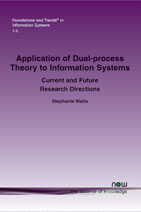Application of Dual-process Theory to Information Systems: Current and Future Research Directions
By Stephanie Watts, Department of Information Systems, Questrom School of Business, Boston University, USA, swatts@bu.edu
Abstract
This monograph presents a research agenda for the application of dualprocess theories to Information Systems (IS) research. It begins by clarifying exactly what a dual-process approach to attitude formation is, explaining how and why it can provide insights that other theoretical approaches cannot. Similarities and differences between the two dominant dual-process theories — the Elaboration Likelihood Model (ELM) and the Heuristic Systematic Model (HSM) are discussed. These concepts are illustrated in a review of 26 published dual-process-based IS studies. This body of research is categorized according to a logical schema based on the locus of attitude formation. We then distill from these studies those heuristic cues and moderating factors that are most relevant to understanding IS phenomena. Finally, we identify the following three IS phenomena as offering great potential for further applications of the dual-process approach: First, information filtering under information surplus; second, how credibility assessment interacts with system design features; and third, mediated knowledge work in situ. We hope that by so doing, we can prevent future fragmentation of this widely varied body of research, and avoid premature closure around only a subset of potential areas for dual-process-based IS research.
Application of Dual-process Theory to Information Systems: Current and Future Research Directions
Application of Dual-process Theory to Information Systems: Current and Future Research Directions addresses the dual-process approach to attitude formation as it has been applied to the domain of Information Systems (IS). It describes twenty six empirical research studies published in the IS literature that have been based on the Elaboration Likelihood Model (ELM) or the Heuristic Systematic Model (HSM) – variants of the dual-process approach. Some of the IS phenomena that these studies have explored include the IS training process, website trust and privacy assurance, perceptions of online health records, adoption of expert systems' advice, design of recommendation systems, computer-mediated communication, and knowledge management.
Application of Dual-process Theory to Information Systems: Current and Future Research Directions starts by clarifying exactly what a dual-process approach is and how to apply it. The author then defines a logical schema for categorizing the extant dual-process IS research, using it to group these studies into these categories and briefly reviewing each study. This helps to address the need to understand these studies in relation to each other with the aim of integrating them and forestalling fragmentation of this body of work. The discussion section begins by identifying three streams of this research that are outliers, and then examines those heuristic cues and moderating factors in the studies reviewed that are clearly IS constructs; suggesting they bear further dual-process based IS research. Finally, the author elucidates three particular IS phenomena that present excellent opportunities for applying this approach in the future: (1) information filtering during complex problem solving, (2) how trust and credibility assessment interact with system design features, and (3) organizational knowledge work.
